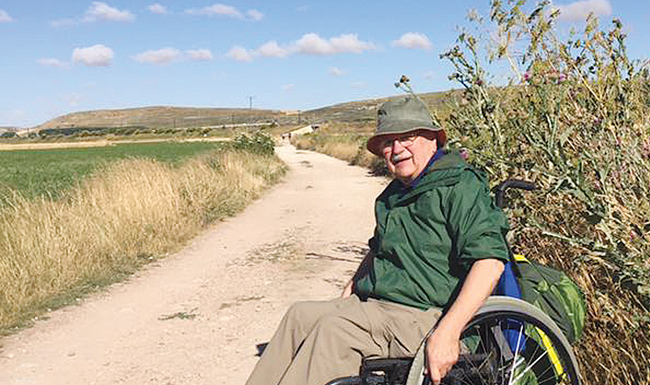By SUZANNE KOZIATEK
Contributing Writer
Monsignor Thomas Flach’s journey in the priesthood took a difficult turn more than 10 years ago, when an unexpected illness slowed his steps.
But Monsignor Flach, who retires this summer as pastor of St. Joseph Parish in Marion and St. Paul Parish in Johnston City, calls his diagnosis of Guillain-Barré syndrome “a gift,” one that allowed him to grow in his faith.
“Although the whole experience was one I wouldn’t want to do again, I got the opportunity to know God’s presence through the support of my family and friends,” he says. “My parishioners were wonderful.”
And it didn’t deter him from making a life-changing pilgrimage to Spain two years ago, traveling the famous Camino de Santiago by wheelchair.
“It was a wonderful experience,” Father Flach says. “I’m grateful to have had the opportunity.”
It was a continent away from his childhood in Belleville, where he attended St. Mary Parish School. He says he heard the call of his vocation as a young man, inspired by the example of the priests in his parish and the School Sisters of Notre Dame, who taught him in school. “I was moved by their joy and presence.”
But even at that age, he had a taste for travel, and when he was introduced to St. Meinrad Seminary in southern Indiana, he chose it over the more familiar St. Henry’s Seminary in Belleville.
Upon his ordination, Monsignor Flach served as assistant pastor, first at St. Albert the Great in Fairview Heights and then at St. Stephen in Caseyville.
In 1976, he was assigned to his first post as pastor, at St. Patrick’s in Ruma and St. Leo’s in Modoc. He also served as chaplain of the Motherhouse of the Adorers of the Blood of Christ in Ruma. Father Flach later served as pastor of St. Cecilia Parish in Bartelso, St. Stephen Parish in Caseyville, and Ss. Peter and Paul Parish in Waterloo.
It was while he was pastor at Ss. Peter and Paul that Father Flach first began to feel the effects of Guillain-Barré syndrome, a condition in which the body’s immune system attacks the nerves. In Monsignor Flach’s case, it affected his legs, requiring him to undertake months of therapy at the Rehabilitation Institute of St. Louis, and later at a nursing home in Waterloo.
“I began walking with braces, and went to Albuquerque to live with my sister and brother-in-law, Janet and Tim Maher,” Monsignor Flach says. “I continued to receive outpatient therapy, and eventually could walk with a walker and no braces, and was able to start driving again.”
Upon returning to the Diocese of Belleville, he was reassigned to St. Joseph, a newer church whose facilities were more accessible for him.
Throughout his therapy and recovery, Monsignor Flach followed the example of St. Paul, “boasting in his infirmities” instead of seeing them as a barrier to his journey in faith. He says it often helped him when he dealt with parishioners and others who struggled physically.
“I would go to the V.A. Hospital, where I was a part-time chaplain,” he says. “Some of the veterans were suffering, and when I would walk in with my cane, they would see that, and you could see them thinking, ‘yeah, he gets it.’”
Monsignor Flach’s condition didn’t prevent him from taking on the 250-mile pilgrimage to the Cathedral of St. James near the western coast of Spain. El Camino de Santiago, or “The Way of St. James,” refers to a collection of routes leading to the shrine of St. James the Apostle in Galicia. Thousands of pilgrims from all over the world make the journey each year.
Monsignor Flach says he had wanted to make the trek years ago, when a number of other local Catholics undertook it. “I was enthralled by it, but didn’t take the opportunity.”
But a trip to Avila, Spain, to visit a friend reignited the idea. “I fell in love with Spain.”
He enlisted the help of his nephew, Keyan Welch, and in the summer of 2016, they set out on what is known as the “French route” of the Camino.
“I did it in a wheelchair,” Monsignor Flach says. “I pushed myself for much of the trip – I worked on that – and Keyan pushed me, with the assistance of fellow pilgrims.” They averaged about 12 to 15 miles a day, staying in hostels along the route.
After weeks of travel, Monsignor Flach and his nephew arrived at the famous Cathedral of Santiago de Compostela the day after the Feast of St. James. He came away with indelible memories of the trip and the people he met.
With a laugh, he remembers “flying down a hill in my wheelchair – no helmet, no padding.”
And he says he felt God’s presence in his fellow pilgrims.
“Those were very spiritual moments.”
Now, Monsignor Flach is preparing for retired life and a move back to Albuquerque. He once again will share a home with this sister and brother-in-law: “Their generosity is unbelievable.”
But as always, he’s ready for more learning and growing. He plans to work on his Spanish, and assist as a substitute priest at another St. Joseph church, St. Joseph on the Rio Grande.
“It’s time for me to begin a different stage of my life.”







